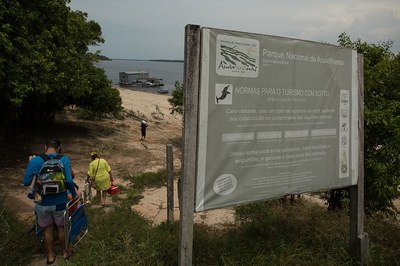National Park near Manaus seeks a closer connection with society through interpretive materials
In June, new interpretive signs were installed at the Anavilhanas river archipelago and on the river shores near Novo Airão – one of the main points of entry to the Anavilhanas National Park, in the state of Amazonas. Boatmen and guides have also been given plastic folders to help them describe the importance of the Park to visitors and develop closer emotional bonds with the area. All the material is bilingual, geared not only to national and international visitors, but also to the residents of Novo Airão.
The products were developed by the Park's management team in partnership with the United States Forest Service and Colorado State University. Both signs and folders were designed and produced in line with the Park's Interpretive Plan during participatory workshops that included boatmen, local guides and artists.
Park Manager Priscila Santos explained that environmental interpretation is a way to encourage the involvement of the people who know the region well. Anavilhanas is the second largest river archipelago in the world, with more than 400 islands, and this initiative aims at supporting its conservation. “These materials are of key importance for our communication with society about the Park, its ecological attributes and international titles. “We aim not only to inform but also to sensitize our visitors, making people proud of the National Park and promoting its protection and conservation. In Brazil, we say that lack of communication leads to trouble. Interpretive materials containing quality information are tools for advancing communication with society and adding structure to our visitation programs.”
The signs were unveiled on June 5, World Environment Day, with the participation of local artists, representatives of the Association of Drivers and Tour Operators of Manaus and Novo Airão, local NGOs, the Novo Airão City Hall, the Amazonas State Secretariat for Tourism, the United States National Association for Interpretation and Colorado State University, as well as ICMBio's local team and its Regional Coordinator based in Manaus.
The experience of Anavilhanas as a demonstrative site for environmental interpretation was presented at the International Interpretation Conference in Rio de Janeiro. Currently, there are also plans to produce interpretation materials aimed at the environmental education of children and young people living in the Lower Rio Negro Mosaic, the wider region that includes the Anavilhanas National Park.


